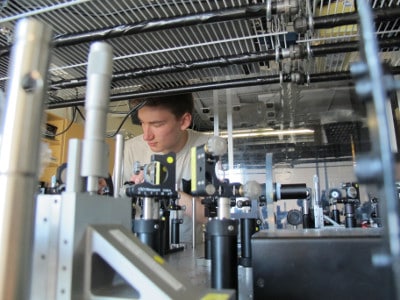
 Jeff Krupa, a third-year UBC Okanagan physics student at the Irving K. Barber School of Arts and Sciences, will be heading to Geneva, Switzerland in July to work on the ATLAS experiment, one of four major initiatives currently underway at the European Organization for Nuclear Research, or CERN.
Jeff Krupa, a third-year UBC Okanagan physics student at the Irving K. Barber School of Arts and Sciences, will be heading to Geneva, Switzerland in July to work on the ATLAS experiment, one of four major initiatives currently underway at the European Organization for Nuclear Research, or CERN.
Part of CERN’s Large Hadron Collider, ATLAS is a 7,000-tonne detector, buried 100 metres below a village in Switzerland, taking part in the search for still-unknown fundamental particles.
“There are only seventeen known particles in the world,” says Krupa. “The ATLAS experiment uses the Large Hadron Collider to create high energy collisions. It is only under these extreme conditions that we see new particles. This type of particle hunting is pure physics, but in the future, newly discovered particles can form the basis of advancements in engineering and other scientific fields.”
The centre of the 46-metre long ATLAS detector is where beams of particles from the Large Hadron Collider smash into each other, the debris from which is analyzed and measured.
On July 4, 2012, both the ATLAS and CMS experiments at CERN announced that they had each observed a new particle consistent with the Higgs boson, predicted by the Standard Model of particle physics.
New discoveries in the field could point to the existence of other dimensions, gravitrons and tiny black holes, which could explain why gravity is as weak as it is, or help us understand the role of dark matter in the universe, which apparently makes up 27% of the universe even though we can’t currently detect it and basically don’t know anything about it.
_____________________________________________________________________________________________________________________________
This article is brought to you by Apivio Systems (TSXV:APV)

In 2003, Rob Bakshi sold Vancouver-based CCTV firm Silent Witness to Honeywell for $90-million. Click here to learn about his next venture, Apivio Systems.
_____________________________________________________________________________________________________________________________
Last January, Krupa was co-author of a paper published in Nature called “Integration of photonic nanojets and semiconductor nanoparticles for enhanced all-optical switching”, which addresses the scientific basis of emerging all-optical networks and processors.
Working at the Barber School of Arts and Sciences allows students to earn a degree in the field of their choice while making connections with other areas of study.
“As a science student, my journey took a positive and unexpected turn when I began working in an engineering lab,” said Krupa. “Applying the analytical methods developed in my physics classes to real-world systems in the Integrated Optics Laboratory gives me a broader understanding and perspective on difficult research questions.”
After he finishes an eight-week term at the TRIUMF subatomic physics lab at UBC’s Vancouver campus, Krupa will be one of four Canadian undergraduate students joining the international research team working on ATLAS, which consists of more than 3,000 scientists visiting from 174 institutes in 38 countries.
Take a guided tour of ATLAS here.
Leave a Reply
You must be logged in to post a comment.



 Share
Share Tweet
Tweet Share
Share




Comment